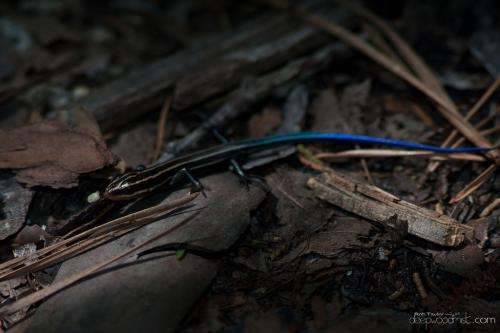Receptor tyrosine kinase c-Met controls the cytoskeleton from different endosomes via different pathways Ludovic Ménard

Brightly coloured lizard tails have evolved as a 'risky decoy' defence strategy against bird attacks, new research suggests.
Curtin University's Dr Bill Bateman and Murdoch University's A/Professor Trish Fleming say their findings support the hypothesis that while increasing the frequency of attack, brightly-coloured tails divert predatory attention away from the head and body, ultimately increasing a lizard's chance of survival.
To test the theory, they created 48 models of a scincid lizard, half of which were coloured all brown, and half given blue tails.
Pairs of blue-tailed and all-brown lizards were placed in 24 locations, with pairs 300 metres apart, and individuals 25 metres apart, in semi-open conditions on white sand or leaf litter.
Over a week, the researchers assessed damage and damage location daily, recording attacks at 23 of 24 locations, with 65 incidences in total, 60 of which were attributed to birds.
The researchers found that all-brown models suffered an attack to the tail only twice, while blue-tailed models lost their tails on 11 occasions.
The all-brown models were also more frequently attacked on the head and body, which would likely be fatal for a real lizard.
Bright tails increase risk of attack but improve survival likelihood
"Our study is the first to show that brightly-coloured tails pose additional risk for lizards in that conspicuous colouration may increase the likelihood of being attacked; but if that attack can be directed towards the autotomous tail, this may ultimately increase the chances survival," Dr Bateman says.
"It seems counterintuitive that a prey organism should make itself more obvious to predators through behaviour or colouration, and this was the main reason for the emphatic dismissal of a decoy function of the blue tail by past researchers."
Previous theories proposed that highly visible markings and colourations on certain skink, teid and lacertid lizard species could be intended to signal their unprofitability to potential predators or act as social signals, such as indicating juvenile status.
Dr Bateman says, instead, that the colouring of juveniles may reflect defensive needs related to foraging patterns, with hatchlings of some species needing to forage more actively than adults in microhabitats with greater risks of predation.
He adds that the risky-decoy hypothesis has been supported in orb-spiders, who decorate their webs with clusters of prey remains and silks to create 'decoy spiders', raising the chances of attack but increasing the likelihood that a decoy will be the predatory target.
Provided by Science Network WA



















